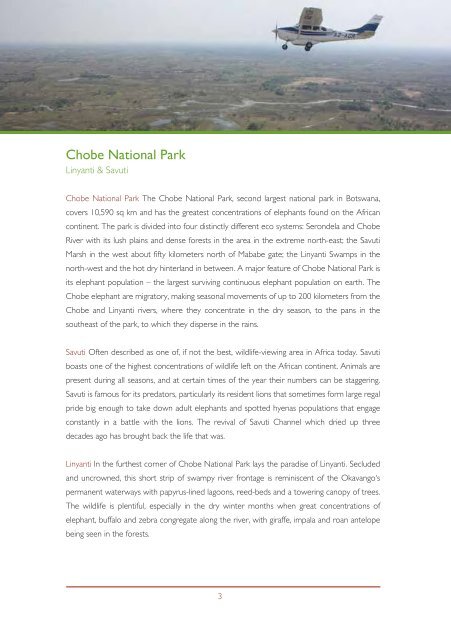Create successful ePaper yourself
Turn your PDF publications into a flip-book with our unique Google optimized e-Paper software.
Chobe National Park<br />
Linyanti & Savuti<br />
Chobe National Park The Chobe National Park, second largest national park in Botswana,<br />
covers 10,590 sq km and has the greatest concentrations of elephants found on the African<br />
continent. The park is divided into four distinctly different eco systems: Serondela and Chobe<br />
River with its lush plains and dense forests in the area in the extreme north-east; the Savuti<br />
Marsh in the west about fifty kilometers north of Mababe gate; the Linyanti Swamps in the<br />
north-west and the hot dry hinterland in between. A major feature of Chobe National Park is<br />
its elephant population – the largest surviving continuous elephant population on earth. The<br />
Chobe elephant are migratory, making seasonal movements of up to 200 kilometers from the<br />
Chobe and Linyanti rivers, where they concentrate in the dry season, to the pans in the<br />
southeast of the park, to which they disperse in the rains.<br />
Savuti Often described as one of, if not the best, wildlife-viewing area in Africa today. Savuti<br />
boasts one of the highest concentrations of wildlife left on the African continent. Animals are<br />
present during all seasons, and at certain times of the year their numbers can be staggering.<br />
Savuti is famous for its predators, particularly its resident lions that sometimes form large regal<br />
pride big enough to take down adult elephants and spotted hyenas populations that engage<br />
constantly in a battle with the lions. The revival of Savuti Channel which dried up three<br />
decades ago has brought back the life that was.<br />
Linyanti In the furthest corner of Chobe National Park lays the paradise of Linyanti. Secluded<br />
and uncrowned, this short strip of swampy river frontage is reminiscent of the Okavango‘s<br />
permanent waterways with papyrus-lined lagoons, reed-beds and a towering canopy of trees.<br />
The wildlife is plentiful, especially in the dry winter months when great concentrations of<br />
elephant, buffalo and zebra congregate along the river, with giraffe, impala and roan antelope<br />
being seen in the forests.<br />
3


